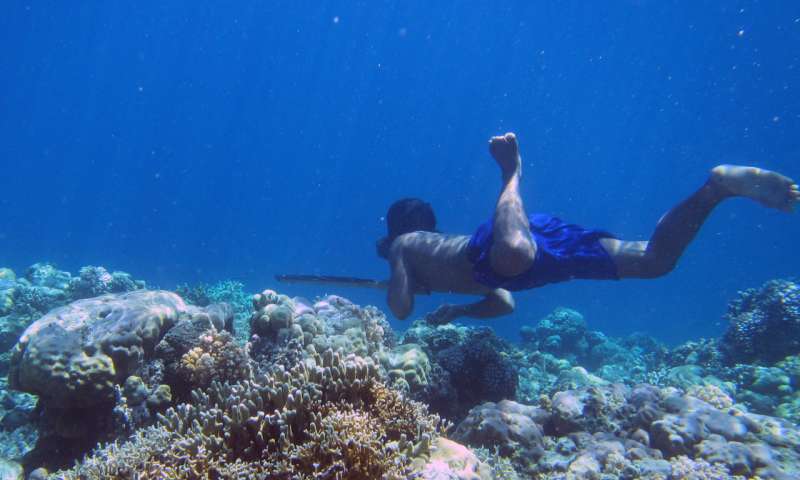Scientists have found evidence that some humans have genetically adapted to diving by studying the Bajau, a group of people indigenous to parts of Indonesia. The Bajau, also known as ‘Sea Nomads’, have enlarged spleens that allow them to dive to depths of up to 70 m (230 ft.).
The genetics of the perfect dive
Melissa Ilardo spent several months in Jaya Bakti, Indonesia taking genetic samples and performing ultrasound scans of the spleens of both the Bajau and their land-dwelling neighbors, the Saluan. She had a hunch that the Bajau had genetically adapted in order to be able to dive to staggering depths. Carrying only a spear, some weights, and wood goggles, some Bajau divers can stay underwater routinely for 15 minutes. They have been living this hunter-gatherer way of life for thousands of years.
The spleen is directly related to how long a person can dive. When the human body is submerged under cold water, even for just a few seconds, it triggers the so-called ‘human dive response.’ During this state, the heart rate slows down, blood vessels in the extremities shrink, and the spleen contracts. This latter action of the spleen gives the body an oxygen boost — up to 9% extra O2 — by ejecting oxygenated red blood cells into the bloodstream, thereby prolonging dive time.
“There’s not a lot of information out there about human spleens in terms of physiology and genetics,” Ilardo said, “but we know that deep-diving seals, like the Weddell seal, have disproportionately large spleens. I thought that if selection acted on the seals to give them larger spleens, it could potentially do the same in humans.”
Ilardo undertook this study for her Ph.D. at the University of Copenhagen, where her supervisions, Professor Eske Willerslev and Professor Rasmus Nielsen advised her against it. The two professors were of the opinion that Ilardo risked finding nothing. “She said she wanted to do it anyway and that paid off. Melissa was right and our concerns were wrong,” said Professor Willerslev.
The study first showed that the Bajau have a median spleen size 50% larger than the Saluan. Enlarged spleens were visible in non-diving Bajau individuals as well as those who regularly free dive, which eliminated the objection that it was all just a plastic response to diving.
Genetic sequencing of Bajau individuals revealed they carry a gene called PDE10A which the Saluan do not. Ilardo and colleagues say that the PDE10A gene controls the levels of thyroid hormone T4. It is these heightened thyroid hormone levels that cause the spleen to grow much larger than that of probably all other people in the rest of the world.
“It’s been shown in mice that thyroid hormones and spleen size are connected. If you genetically alter mice to have an absence of the thyroid hormone T4, their spleen size is drastically reduced, but this effect is actually reversible with an injection of T4,” Ilardo said.
Until now, scientists were not sure if Sea Nomad people were genetically adapted to their extreme lifestyle. The new study now provides the first evidence that such a genetic adaptation has been tracked in humans. Previously, researchers also studied the superior underwater vision of Thai Sea Nomad children but found this was a plastic response to training rather than a genetic adaptation.

In this photo, a Bajau diver hunts fish underwater using a traditional spear. Credit: Melissa Ilardo.
The findings could have important implications for medical research. It’s well established that the human dive response essentially simulates acute hypoxia, which is the body’s response to a rapid depletion of oxygen. Acute hypoxia is one of the leading causes of complications in emergency care, so any alternative means of treating it could save human lives. For instance, the new study might one day lead to an association between genetics and physiological response to acute hypoxia.
Perhaps studies on other prolific divers can provide even more clues. Besides Sea Nomads, other populations with similar diving prowess include the Thai Moken population and the Haenyeo diving women of Jeju in South Korea.
“This study is a wonderful example of the value of studying these small populations living under extreme conditions,” said Professor Eske Willerslev. “A lot of them are threatened and this is not just a loss culturally and linguistically, but for genetics, medicine, and sciences in general. There’s still a lot of information to be gathered from these understudied populations.”










